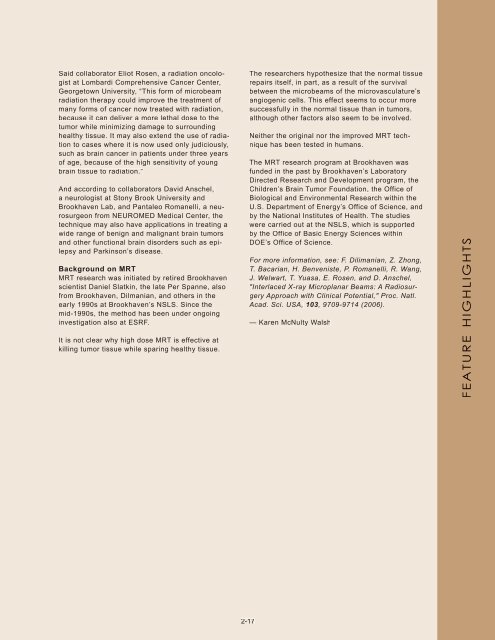NSLS Activity Report 2006 - Brookhaven National Laboratory
NSLS Activity Report 2006 - Brookhaven National Laboratory
NSLS Activity Report 2006 - Brookhaven National Laboratory
You also want an ePaper? Increase the reach of your titles
YUMPU automatically turns print PDFs into web optimized ePapers that Google loves.
Said collaborator Eliot Rosen, a radiation oncologist<br />
at Lombardi Comprehensive Cancer Center,<br />
Georgetown University, “This form of microbeam<br />
radiation therapy could improve the treatment of<br />
many forms of cancer now treated with radiation,<br />
because it can deliver a more lethal dose to the<br />
tumor while minimizing damage to surrounding<br />
healthy tissue. It may also extend the use of radiation<br />
to cases where it is now used only judiciously,<br />
such as brain cancer in patients under three years<br />
of age, because of the high sensitivity of young<br />
brain tissue to radiation.”<br />
And according to collaborators David Anschel,<br />
a neurologist at Stony Brook University and<br />
<strong>Brookhaven</strong> Lab, and Pantaleo Romanelli, a neurosurgeon<br />
from NEUROMED Medical Center, the<br />
technique may also have applications in treating a<br />
wide range of benign and malignant brain tumors<br />
and other functional brain disorders such as epilepsy<br />
and Parkinson’s disease.<br />
Background on MRT<br />
MRT research was initiated by retired <strong>Brookhaven</strong><br />
scientist Daniel Slatkin, the late Per Spanne, also<br />
from <strong>Brookhaven</strong>, Dilmanian, and others in the<br />
early 1990s at <strong>Brookhaven</strong>’s <strong>NSLS</strong>. Since the<br />
mid-1990s, the method has been under ongoing<br />
investigation also at ESRF.<br />
It is not clear why high dose MRT is effective at<br />
killing tumor tissue while sparing healthy tissue.<br />
The researchers hypothesize that the normal tissue<br />
repairs itself, in part, as a result of the survival<br />
between the microbeams of the microvasculature’s<br />
angiogenic cells. This effect seems to occur more<br />
successfully in the normal tissue than in tumors,<br />
although other factors also seem to be involved.<br />
Neither the original nor the improved MRT technique<br />
has been tested in humans.<br />
The MRT research program at <strong>Brookhaven</strong> was<br />
funded in the past by <strong>Brookhaven</strong>’s <strong>Laboratory</strong><br />
Directed Research and Development program, the<br />
Children’s Brain Tumor Foundation, the Office of<br />
Biological and Environmental Research within the<br />
U.S. Department of Energy’s Office of Science, and<br />
by the <strong>National</strong> Institutes of Health. The studies<br />
were carried out at the <strong>NSLS</strong>, which is supported<br />
by the Office of Basic Energy Sciences within<br />
DOE’s Office of Science.<br />
For more information, see: F. Dilimanian, Z. Zhong,<br />
T. Bacarian, H. Benveniste, P. Romanelli, R. Wang,<br />
J. Welwart, T. Yuasa, E. Rosen, and D. Anschel,<br />
"Interlaced X-ray Microplanar Beams: A Radiosurgery<br />
Approach with Clinical Potential," Proc. Natl.<br />
Acad. Sci. USA, 103, 9709-9714 (<strong>2006</strong>).<br />
— Karen McNulty Walsh<br />
2-17<br />
FEATURE HIGHLIGHTS

















